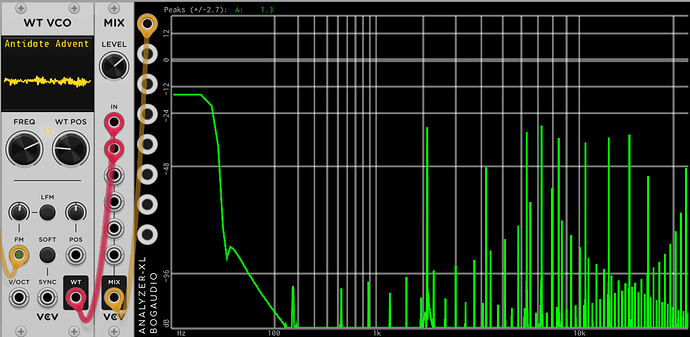I guess the wobbly signal on the Scope indicates some anti-aliasing taking place ?
hard to say. It could be just the natural ringing you would get from a mild lowpass filter?
I’m not too experienced in what to expect from these FFT whatchamacallit’s
fair enough. It is a little esoteric. The basic thing is if you have an osc at freq = f, you would expect to see lines for all the harmonics, so possibly f, 2f, 3f, 4*f, etc… If you see something that isn’t at one of those frequencies, then it’s “something bad”. Typically aliasing is only easy to see/hear at high frequences.
I wrote something a year or so about this: Demo/docs/aliasing2.md at main · squinkylabs/Demo · GitHub
There’s a lot of experience going into seeing the aliasing ugliness of the “Antidote Advent” you posted. to me it looks like a complex waveform with some (filtered) noise in it. I wouldn’t be able to recreate it i think.
But, I’m slowly getting a basic understandig of the fundamentals and the (infinite) odd/even overtones in the time/frequency domains.
Yeah, and it helps to know the fundamental freq. in that one I think the fundamental was a bit over 2k, so the lines at 2k, 4K, 6k are good harmonics, and the lines in between are bad stuff . But it is at a lower level, which is good.
I think it may just be the way the scope in V2 draws - it seems to draw lines almost calligraphically with thicker horizontal lines and thinner vertical ones.
In one of the recent livestreams Vortico mentioned that the WT VCO does precomputed anti-aliasing. The wobbly-ness of the shape changes in some intervals of pitch to provide the right amount for different frequencies.
Well, there must be an issue. The spectrum doesn’t lie… there are incorrect frequencies in there.
Maybe it depends a lot on the number of wavepoints? The Surge oscillators for example sound quite crappy with 256, but really good with 2048. I remember reading about Surge that the wavetable oscillators have no “inharmonic aliasing”, but instead can have a lot of “harmonic aliasing”, maybe that’s the same thing going on here.
I don’t understand. The FFT shows frequencies below the fundamental. That’s not a harmonic. I’ll look more how this one works, but wavetable are well know to do regular old aliasing if you transpose them up so they the waveform has harmonics above nyquist. Some WT go to great length to reduce this, the others don’t.
I think what was meant by that was that they do produce inharmonic overtones, but those always follow the pitch and don’t get mirrored and move about… If the WT VCO does it’s recalculations with the same resolution as the wavetable that is being read it might produce something like that at low resolutions. Something like bitcrushing before pitching maybe.
Hi! It seem to be a good solution to my problem. I got a few question for you:
wich wave form did you put into WT VCO? I tried the module but with the basic wave I can’t change triangle symmetry.
Do you change symmetry using the POS parameter?
Do you know a method to rotate the wave phase bipolar?
Where I can find the wavetable for this module?
Thanks a lot!
If you look more closely at his post you can see he made a custom wave table to do this. He provided a link to it.
The assymmetric triangle is called “wavetable.wav”, set WST VCO wavepoints to 2048 and load. POS to change the symmetry.
AND you want to modulate the phase +/- 2pi rad with a +/- 10 CV?
I don’t know how.
some kind of a * x + b thing, like one of the many attenuverter modules?
Thank you so much, now I found it. That’s the best solution I could immagine for my problem. Phase rotation excluded, the only regret is the loss of the Analog/Digital function selector. Do you how can I find these wavetables?
Square (with PWM) (Both digital and analog version) Sin (with Simmetry control) (Both digital and analog version) Triangle (the same you yet linked me but analog version)
No, I don’t know.
Perhaps they are in a collection somewhere.
I only know this:
I’m not 100% sure what you’re trying to achieve but this might also work: troika - Triple Ocillator - Instruō Modular - Glasgow, Scotland



